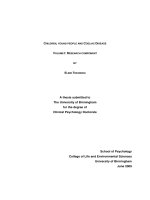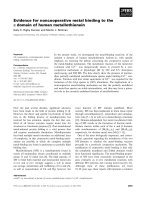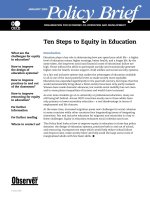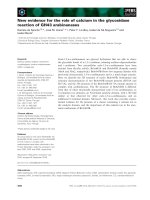Evidence for the Ten Steps to Successful Breastfeeding docx
Bạn đang xem bản rút gọn của tài liệu. Xem và tải ngay bản đầy đủ của tài liệu tại đây (934.33 KB, 118 trang )
WHO/CHD/98.9
DISTR.: GENERAL
ORIGINAL: ENGLISH
Evidence for the
Ten Steps to Successful Breastfeeding
DIVISION OF CHILD HEALTH AND DEVELOPMENT
World Health Organization
Geneva
1998
© World Health Organization 1998
This document is not a formal publication of the World Health Organization
(WHO), and all rights are reserved by the Organization. The document may,
however, be freely reviewed, abstracted, reproduced or translated, in part or in
whole, but not for sale or for use in conjunction with commercial purposes.
The designations employed and the presentation of the material in this
document do not imply the expression of any opinion whatsoever on the part of
the Secretariat of the World Health Organization concerning the legal status of
any country, territory, city or area or of its authorities, or concerning the
delimitation of its frontiers or boundaries.
The views expressed in documents by named authors are solely the
responsibility of those authors.
Cover illustration adapted from a poster by permission
of the Ministry of Health, Peru.
iii
Contents
INTRODUCTION
1
Methods used in the review
Presentation of information
The Ten Steps to Successful Breastfeeding
1. Step 1: Policies
6
1.1 Criteria 6
1.2 Introduction 6
1.3 Effectiveness of breastfeeding policies 6
1.4 Results of weak policies 7
1.5 Policies which discourage or interfere with breastfeeding 8
1.6 Effectiveness of strong policies 9
1.7 Elements of a policy 10
1.8 Process of policy development 11
2. Step 2: Training
14
2.1 Criteria 14
2.2 Introduction 14
2.3 Knowledge, attitudes and practices of health care staff 14
2.4 Effectiveness of training 15
2.5 Length of training courses 17
2.6 Conclusions 17
3. Step 3: Antenatal preparation
23
3.1 Criteria 23
3.2 Introduction 23
3.3 Influences on breastfeeding intentions 23
3.4 Evidence for the benefits of antenatal education 24
3.5 Evidence for the benefits of nipple preparation 25
3.6 Conclusions 26
4. Step 4: Early contact
31
4.1 Criteria 31
4.2 Introduction 31
4.3 Effect of early contact on breastfeeding 31
4.4 Other outcomes 33
4.5 Analgesia during labour and delivery 34
4.6 Conclusions 34
iv
5. Step 5: Guidance
40
5.1 Criteria 40
5.2 Introduction 40
5.3 Showing mothers how to breastfeed 41
5.4 Helping mothers who are separated from their infants in hospital 42
5.5 Conclusions 44
6. Step 6: Use of supplements
48
6.1 Criteria 48
6.2 Introduction 48
6.3 Effect of in-hospital prelacteal feeds and supplements on
breastfeeding 48
6.4 Effects of supplements after discharge on breastfeeding 51
6.5 Other outcomes 51
6.6 Effect of commercial samples of breastmilk substitutes on
breastfeeding 52
6.7 Impact and cost-effectiveness of restricting formula in maternity
wards 53
6.8 Conclusions 53
7. Step 7: Rooming-in
62
7.1 Criteria 62
7.2 Introduction 62
7.3 Effect of rooming-in on breastfeeding 62
7.4 Other outcomes 64
7.5 Validity of reasons for not rooming-in 64
7.6 Effect of co-sleeping on breastfeeding and other outcomes 65
7.7 Conclusions 65
8. Step 8: Feeding on demand
68
8.1 Criteria 68
8.2 Introduction 68
8.3 Frequency and length of suckling soon after birth 68
8.4 The effect of unrestricted breastfeeding 69
8.5 Other outcomes 70
8.6 Conclusions 70
9. Step 9: Teats and pacifiers
74
9.1 Criteria 74
9.2 Introduction 74
9.3 Effect of artificial teats on breastfeeding 74
9.4 Effect of pacifiers on breastfeeding 75
9.5 Other effects of artificial teats and pacifiers 77
9.6 Conclusions 78
v
10. Step 10: Continuing support
82
10.1 Criteria 82
10.2 Introduction 82
10.3 Effect of post-discharge support on breastfeeding:
Health services 83
10.4 Effect of post-discharge support on breastfeeding:
Mother-to-mother support groups 84
10.5 Effect of post-discharge support on breastfeeding:
Community-based peer counsellors 84
10.6 Conclusions 85
11. Combined interventions
93
11.1 Introduction 93
11.2 Effect on breastfeeding practices 93
11.3 Effect of combined interventions on cost-effectiveness and
morbidity 94
CONCLUSIONS AND RECOMMENDATIONS
100
REFERENCES
103
List of abbreviations
111
List of methodological limitations
111
vi
Acknowledgements
The authors of this review were Dr Constanza Vallenas and Dr Felicity Savage. Valuable
assistance for the analysis was provided by Dr Jose Martines.
Many thanks are due to the following people for reviewing the document in draft and for
providing helpful, constructive criticism: Ms Helen Armstrong (UNICEF, New York), Ms
Beverley Chalmers (Ontario), Dr Gülbin Gokçay (University of Istanbul), Dr Rukshana Haider
(International Centre for Diarrhoeal Disease Research, Bangladesh), Ms Elizabeth Kylberg
(Uppsala University), Ms Ludmila Lhotská (UNICEF, New York), Dr Nancy G. Powers
(University of Kansas), Professor Mary Renfrew (University of Leeds), Dr Wendelin Slusser
(University of California, Los Angeles), Dr Cesar G. Victora (Federal University of Pelotas), Dr
Michael Woolridge (University of Leeds).
Thanks also to members of WHO’s Technical Working Group on Breastfeeding representing
other units: Mrs R Saadeh, Nutrition Programme, and Dr J Zupan, Division of Reproductive
Health (Technical Support) who made helpful comments. Thanks are also due to Dr Chessa
Lutter (Food and Nutrition Program, PAHO/WHO) for her valuable comments, and Dr Nadia
Meyer for reviewing the list of references.
1
EVIDENCE FOR THE
TEN STEPS TO SUCCESSFUL BREASTFEEDING
INTRODUCTION
The “Ten Steps to Successful Breastfeeding” are the foundation of the WHO/UNICEF Baby
Friendly Hospital Initiative (BFHI). They summarize the maternity practices necessary to
support breastfeeding. The purpose of this document is to review the evidence for the efficacy
of the ‘Ten Steps’, and to provide a tool for both advocacy and education. It is hoped that
policies and practices in future will be based on research rather than on conjecture and custom
(Inch & Garforth, 1989).
There are a number of papers which present the rationale for some or all of the ‘Ten Steps’
(Perez-Escamilla et al, 1994; Saadeh & Akré, 1996) but there remains a need for a
comprehensive and critical review of available evidence.
The BFHI was developed to promote implementation of the second operational target of the
Innocenti Declaration:
Ensure that every facility providing maternity services fully practises all ten of the
Ten Steps to Successful
Breastfeeding
set out in the joint WHO/UNICEF statement ‘Protecting, promoting and supporting breast-
feeding: the special role of maternity services’
,
and aspects relevant to health facilities of the third operational target:
Take action to give effect to the principles and aim of all Articles of the International Code of Marketing of
Breast-milk Substitutes and subsequent relevant World Health Assembly [WHA] resolutions in their entirety.
The Innocenti Declaration was adopted by the Forty-fifth World Health Assembly in May 1992
in Resolution WHA 45.34.
The BFHI addresses a major factor which has contributed to the erosion of breastfeeding - that
is, health care practices which interfere with breastfeeding. Until practices improve, attempts to
promote breastfeeding outside the health service will be impeded. Although inappropriate
maternity care cannot be held solely responsible for low exclusive breastfeeding rates,
appropriate care may be a prerequisite for raising them.
Many other factors affect how women feed their infants and the length of time for which they
breasfeed. These have been extensively reviewed by Popkin et al (1983), Forman (1984),
Simopoulos & Grave (1984), Koktürk & Zetterström (1989), Wilmoth & Elder (1995), and
include: 1) living environment (urban or rural), 2) socioeconomic status, 3) maternal education
(Forman, 1984), 4) the woman’s employment situation, and 5) commercial pressures, and
knowledge and availability of breastmilk substitutes (Huffman, 1984). Sociocultural factors
also determine beliefs and attitudes, as well as practices, related to breastfeeding. A woman’s
decision about infant feeding may be influenced by the perceived or actual attitudes of the
child’s father (Freed, Fraley & Schanler, 1993), other family members, and friends; and the
amount of support she may have to carry her decision through.
2
The factors which affect breastfeeding rates are not only many and complex, but they operate
differently in different situations. For example, the influence of a child’s father may depend on
the extent to which in that society a woman’s male partner has control over her body; maternal
education has been associated with higher breastfeeding rates in industrialized countries and
with lower rates in developing countries (Forman, 1984).
Factors may also vary with time in the same community, and partial and exclusive
breastfeeding may have different determinants (Perez-Escamilla et al, 1993). Cultural attitudes
towards breasts as sexual symbols, and women’s confidence in their ability to lactate may also
differ and influence mothers’ attitudes toward breastfeeding. It would not be surprising
therefore to learn that implementation of the ‘Ten Steps’ affects breastfeeding differently in
different communities. The studies reviewed here do show some differences, but these are
mainly of degree rather than of direction. There are more publications from industrialized than
from developing countries, but the available evidence indicates that implementation of the ‘Ten
Steps’ in maternity facilities can increase breastfeeding in almost any setting. Implementing
each Step by itself has some effect, but implementing all of them together can be expected to
have a greater effect, while omiting one or more may limit the impact of those that are in
place.
Thus, although to achieve adequate and sustained increases in breastfeeding, many other
programme components are needed - including employment legislation, widespread public
education, community support, and implementation of the International Code of Marketing of
Breast-milk Substitutes (the Code) - improved health care practices are fundamental. As
summarized in the ‘Ten Steps’, policy development and staff training resulting in appropriate
skilled support of mothers before, during and after delivery, and ongoing postnatal support in
the community, are all necessary to realize the improvements aimed for by other activities.
Methods used in the review
A literature search was conducted to identify published studies relating to each of the ‘Ten
Steps’, and the effect on breastfeeding of their implementation inside health facilities.
Exceptionally studies assessing interventions outside health facilities were included. Although
the main purpose of the BFHI is to increase breastfeeding rates, other outcomes are also
important, both in their own right, and because they may influence decisions about giving
supplementary feeds. Therefore publications relating to outcomes such as infant weight change,
bilirubin levels, and sleep patterns, were also identified.
As far as possible, only randomized controlled (‘experimental’) studies, and controlled studies
where allocation was systematic or when a ‘before and after intervention’ design was used
(‘quasi-experimental’) have been included. They were assessed according to certain pre-
established criteria (Blum & Feachem, 1983; Perez-Escamilla et al, 1994).
Limitations identified for each experimental or quasi-experimental study are listed in the tables
of comparative results, in the first column, and are numbered according to the following list.
3
Major limitations of internal validity:
1. Inadequate control: no baseline data or between-group differences not considered during
analysis.
2. Confounding variables not controlled: such as maternal age, maternal education,
socioeconomic status.
3. Self-selection of participants: breastfeeding outcomes may differ depending on mother’s
motivation to accept or reject an intervention.
4. More than 10% attrition rate (proportion lost to follow-up), unevenly distributed between
intervention and control groups.
5. Undetermined internal validity: unreported attrition, poorly documented methodology or
unpublished brief communication.
Minor limitations of experimental or quasi-experimental studies:
6. One-to-one comparison: when assessing a group-based intervention such as education, any
difference found by comparing results of one group (ward, nursery) with another group may
not reflect actual effects of the intervention. The strength of evidence is reduced.
7. Long recall period: few data about recall periods relating specifically to breastfeeding exist.
Margen et al (1991) reported from a study in Mexico that “ the overall recall bias [at 3
months of feeding practices at 2 weeks] was towards mothers remembering more
breastfeeding and less bottle-feeding than they had actually practiced earlier”. A time lapse
greater than 6 months was considered unsatisfactory for the purposes of this review.
8. Unclear definition of breastfeeding indicators:
x ‘exclusive’ or ‘sole’ breastfeeding was considered as ‘full breastfeeding’ if
not defined, or if defined differently from WHO indicators.
x ‘breastfeeding’ was considered as ‘any breastfeeding’ if not defined.
9. Based on planned breastfeeding behaviour as opposed to actual practice. This reduces the
strength of evidence but does not invalidate it.
Most studies do not provide information about long-term effects of health interventions. This
may mask negative effects of inadequate practices, since it is currently observed that once
infants start bottle-feeding the practice is only exceptionally reversed. So a difference in
outcomes between 2 groups may become apparent only after several months. For that reason,
the measurement of long-term breastfeeding outcomes was considered a favourable feature of a
study.
A small sample size may be a limitation when a study compares ‘treatments’ (interventions) to
try to identify the one that provides the best results. A large number of strictly selected
individuals increases the probability of the results being generally (‘externally’) applicable.
When a study intends to look for the cause and effect relationship between a practice and an
outcome the experimental conditions (inclusion and exclusion criteria, baseline and follow-up
variables) must be as rigorous as possible. The sample size should be large enough to detect
statistically significant results between treatment and control groups and should be based on
biologically meaningful differences.
In the field of infant feeding it is particularly difficult to randomize treatment groups.
Therefore, in this review, it was considered necessary to include also non-randomized
prospective cohort studies.
Criteria for including prospective cohort studies were: large sample size, control of selection
4
bias, low proportion lost to follow-up, lost individuals similar to the rest, adequate data
collection and, if possible, use of multivariate or regression analysis to control for possible
confounders. Cross-sectional or retrospective studies were included if they provided useful
observational information and were not seriously methodologically flawed. The measurement
of long-term effects on breastfeeding duration was also considered favourable.
Presentation of information
The information is presented for each step in the following order:
1. The Global Criteria for the step, as defined for the WHO/UNICEF Baby Friendly Hospital
Initiative (1992).
2. An introduction describing the background situation.
3. Evidence from experimental or quasi-experimental studies for breastfeeding outcomes, in
historical order. Studies with fewer limitations are discussed in greater detail. Limitations
of studies are presented separately in the comparative tables.
4. Additional supportive evidence from prospective (longitudinal) or cross-sectional studies.
5. Experimental or supportive evidence for other outcomes.
6. Discussion and conclusions.
7. A comparative table of experimental or quasi-experimental studies, when available, and/or
of longitudinal or cross-sectional studies providing supportive evidence. Year of
publication, country or area where study was conducted, population characteristics and
methodological limitations of the study are included to provide a perspective of comparison
among studies. Methodological limitations are numbered according to the list presented in
the above section. Results presented include the indicator considered (exclusive, full or any
breastfeeding) in relation to duration.
8. The information of one study per step is presented graphically.
The final section presents reports of combined interventions. Studies with several major
limitations were excluded.
5
The Ten Steps to Successful Breastfeeding
Every facility providing maternity services and care for
newborn infants should:
1. Have a written breastfeeding policy that is routinely
communicated to all health care staff.
2. Train all health care staff in skills necessary to
implement this policy.
3. Inform all pregnant women about the benefits and
management of breastfeeding.
4. Help mothers initiate breastfeeding within a half-hour
of birth.
5. Show mothers how to breastfeed, and how to maintain
lactation even if they should be separated from their
infants.
6. Give newborn infants no food or drink other than
breastmilk, unless
medically
indicated.
7. Practice rooming-in allow mothers and infants to
remain together 24 hours a day.
8. Encourage breastfeeding on demand.
9. Give no artificial teats or pacifiers (also called dummies
or soothers) to breastfeeding infants.
10. Foster the establishment of breastfeeding support
groups and refer mothers to them on discharge from
the hospital or clinic.
6
STEP 1
ST
E
1.1 “Have a written breastfeeding policy that is routinely communicated to all health care
staff.”
The health facility should have a written breastfeeding policy that addresses all 10 steps and protects breastfeeding [it]
should be available so that all staff who take care of mothers and babies can refer to it should be visibly posted in all
areas of the health care facility which serve mothers, infants, and/or children and should be displayed in the
language(s) most commonly understood by patients and staff. (The Global Criteria for the WHO/UNICEF Baby
Friendly Hospital Initiative, 1992)
1.2 Introduction
A consistent and sustained improvement in hospital practices is most likely to be achieved if
there are appropriate and specific institutional policies, preferably as a standing requirement of
the routine audit cycle within the facility. Policies may be written, or they may exist and be
implicit without being written. Unwritten policies can be strong and effective, and written
policies may be ignored. However, to effect change in the face of divergent opinion, and to
sustain it when staff changes, a policy needs to be written.
Thus this step requires:
1) Appropriate policies on all practices concerning breastfeeding agreed between relevant
authorities
2) Those policies to be made explicit in a written document
3) All staff and patients to be made aware of the policies.
In addition, authorities both inside a health facility (such as administrators and senior clinical
staff) and outside (for example in the Ministry of Health) must be committed to the policies and
must enforce them. Lack of such committment and cooperation from senior staff can be a
major obstacle to consistent implementation of the ‘Ten Steps’. Ideally policies should also
come as a commitment from parents, health professionals, the mass media, and other
community groups. Lack of commitment appears to be stronger in certain private hospitals
where practices are guided by clients’ comfort and financial considerations rather than long-
term health benefits.
1.3 Effectiveness of breastfeeding policies
It is difficult to use an experimental design to show that policies effect change (Janovsky &
Cassels, 1996). Descriptive and qualitative studies of experiences in different health services
are more useful ways to show relationships between strong or weak policies and good or poor
practices, and may be the best source of information to guide policy development.
More common than an absence of policy is a mixture of some that are appropriate and some
that are inappropriate in the same service, and weakness or inconsistency in their
implementation. There may be confusion about interpretation, and there may be
incompatibilities, such that different practices interfere with each other.
7
Westphal et al (1995) assessed the effectiveness of training a core team on changes in hospital
breastfeeding practices in Brazil. Hospitals where trained teams worked improved their
practices. However, it was acknowledged that a lack of coordination existed between policy-
makers, administrators and health care staff in every facility.
To improve the effectiveness of a breastfeeding policy appropriate practices must be included,
all staff must comply with it, and relevant outcomes should be monitored or audited in order to
get feedback for further policy development.
1.4 Results of weak policies
Reiff & Essock-Vitale (1985) reported a survey in a university hospital in the United States of
America (USA) where most official policies, educational materials and counselling and support
programmes promoted breastfeeding. However, there was no policy to limit the use of infant
formula, and a single brand of ready-to-use infant formula was used daily in the maternity
ward. In the delivery room 66% of mothers had stated a preference for exclusive breastfeeding
but when interviewed at 2 weeks only 23% were breastfeeding without formula supplements.
93% of the mothers using formula at 2 weeks knew the name of the hospital brand and 88%
were using it. Thus, lack of a policy on one step may interfere with the effect of implementing
the others.
Winikoff et al (1986) observed institutional constraints on breastfeeding in a hospital in the
USA. Breastfeeding mothers and infants were often separated for long periods and the infants
were given formula despite written policies to the contrary. There was confusion about which
drugs, when given to the mother, might be contraindicated with breastfeeding and about the
identification of breastfeeding mothers. A programme which included staff training,
development of educational materials, and institution of a breastfeeding counselling service had
a limited effect, possibly because no specific effort was made to change policies. The authors
concluded that two elements were essential to achieve change: professional education, and the
willingness of administrative staff to re-evaluate policies and the practices to which they refer.
Garforth & Garcia (1989) surveyed breastfeeding policies and practices in health districts in
England. All directors of midwifery services were surveyed, with a 93% response rate. An in-
depth study was conducted in 8 health districts. The policy of most units was for early mother-
infant contact and rooming-in, but observation showed that practices were inconsistent. One
obstacle to early contact was the separation of mother and baby for other routine procedures.
A policy of demand feeding was reported for 97% of consultant units, but in some night
feeding was restricted. Only 30% of units had a “no fluids” policy, the others giving glucose
water or formula. The authors concluded that there was a need for wide-ranging discussions on
policy, followed by training of staff with a clear explanation of the reasons for changing
inappropriate practices.
Cunningham & Segree (1990) compared the breastfeeding knowledge and practices of mothers
in a rural and an urban hospital in Jamaica. They found that the rural hospital, with implicit
policies supportive of breastfeeding but poor educational resources, had more effect than the
urban hospital which had policies that remained unsupportive of breastfeeding (delayed
8
initiation and frequent formula feeding) but better educational resources. They concluded that
“ limited resources must be used more efficiently by shifting policy rather than by seeking
new technology, programmes or staff.”
Stokamer (1990) found that lack of administrative support and supervision caused the failure of
a breastfeeding promotion programme in an inner-city hospital in the USA. Training sessions
were available to all staff, but attendance was not mandatory and they were poorly attended.
Staff compliance with breastfeeding policies was not assessed by supervisors.
Wright et al (1996) describe the experience of trying to change policies and practices in a
hospital in the USA between 1990 and 1993. More newborns were breastfed in the first hour
of life, fewer received supplementary feeds, and more mothers received guidance in 1993 than
in 1990, but the changes were only partial. The obstetrics department did not participate, and
gift packs containing formula continued to be distributed. The authors state that “the greatest
limitation of the intervention was that it was not a priority for the administrative staff, although
they were generally supportive of the efforts of the task force. For this reason, nurses were
never required to attend in-service sessions, nor were they accountable for giving formula to
infants whose mothers planned to breastfeed exclusively.”
In a study of 5 hospitals (2 public and 3 private) in Turkey, Gökçay et al (1997) found that
none of them was implementing all ‘Ten Steps’. The practice of changing policies according to
clients’ wishes in private hospitals was identified as a barrier to the support of breastfeeding.
1.5 Policies which discourage or interfere with breastfeeding
Inappropriate policies and practices concerning breastmilk substitutes, bottles and teats can
undermine efforts to promote breastfeeding. To become baby-friendly, hospitals are required to
comply with relevant sections of the Code and subsequent relevant WHA resolutions. If
legislation does not exist at national level, policies are needed at facility level. However, even
when breastfeeding policies exist, they may not cover breastmilk substitutes. In a cross-
sectional mailed survey of all Canadian hospitals providing maternity care 58% reported that
they had a written policy on breastfeeding (Levitt et al, 1996). Only 1.3% reported restricting
free samples of formula for mothers at discharge.
Practices which are likely to interfere with breastfeeding, and which are not permitted in baby-
friendly facilities include:
x Distribution or display of posters, calendars or any written materials which promote
artificial feeding or which include brand names of breastmilk substitutes;
x Distribution of free samples of breastmilk substitutes to pregnant women or breastfeeding
mothers in hospital or at discharge;
x Acceptance of free or subsidized supplies of breastmilk substitutes and other products
covered by the Code.
Any breastmilk substitutes that are required should be purchased through normal procurement
channels at not less than 80% of the full price.
Hospital policies related to breastmilk substitutes may be associated with a rapid change in
9
maternal intentions and confidence regarding breastfeeding, even before discharge. Margen et
al (1991) studied health facility policies and practices, including the procurement and use of
infant formula in 3 Mexican regions. Mothers’ intentions and actual breastfeeding practices
were also studied, using a longitudinal qualitative and quantitative design. Of 59 facilities
surveyed, 80% received all formula free. Only 3% reported purchasing formula at full price.
Newborns were fed either glucose water or tea for the first feed, and most were routinely
bottle-fed with formula. 66% of facilities reported giving free formula to mothers at discharge.
On admission 95% of mothers said they planned to breastfeed at home, 54% exclusively, but
while in hospital only 40% breastfed their infants. At discharge, 36% had changed their
intentions at admission in various ways, most of them deciding to increase bottle-feeding or
add formula, and only 43% planned exclusive breastfeeding. Almost two thirds (64%) of
mothers who planned to combine breastfeeding and bottle-feeding thought they would not have
enough milk.
A cross-sectional study of the promotion of breastmilk substitutes was conducted in Poland,
Bangladesh, Thailand and South Africa (The Interagency Group on Breastfeeding Monitoring,
1997; Taylor, 1998). Mothers who recalled receiving company-associated negative information
(i.e. information understood by a woman to promote bottle-feeding and/or to discourage
breastfeeding) were found to be significantly more likely to bottle-feed their infants than
mothers who did not receive such information. The mean age of infants at the time of interview
was 2.5-2.8 months. The methods used allowed the results to be representative of the location
of the study only.
1.6 Effectiveness of strong policies
A number of reports show the advantages of strong policies, for increasing the effectiveness of
interventions. Relucio-Clavano (1981) in the Philippines, Pichaipat et al (1992) in Thailand,
and Valdes et al (1993) in Chile, all showed how improved hospital practices can increase
breasfeeding. They also describe how, to change practices, it was necessary to change policies,
and to ensure awareness and understanding of these policies by medical and nursing staff.
Popkin et al (1991) evaluated a national breastfeeding promotion programme in Honduras
conducted between 1982-1988. Hospitals adopted policies of early breastfeeding, rooming-in
and the elimination of gifts of formula and bottles for mothers. There was a significant increase
in the initiation and duration of breastfeeding, and the authors conclude that changes in hospital
policy and training were the most important aspects of the programme.
Bradley & Meme (1992) reported a national breastfeeding promotion programme which started
in Kenya in 1983. Attitudes and practices in government hospitals improved, and the duration
of breastfeeding in both rural and urban areas had increased in 1989. The principal features of
the programme were adoption of a Code of Marketing of Breastmilk Substitutes; Ministry of
Health directives to all hospitals to stop the distribution of infant formula and to institute early
contact, rooming-in and exclusive breastfeeding; and also training of staff. The policy
directives were regarded as a key component in ensuring widespread implementation of the
programme.
McDivitt et al (1993) in Jordan evaluated a mass media campaign promoting early initiation of
10
breastfeeding and feeding of colostrum. The campaign was effective in increasing early
initiation only among mothers who delivered at home or in hospitals which had a policy
favouring the practice. There was no improvement among mothers delivering in hospitals
without such a policy.
Heiberg & Helsing (1995) describe three surveys of breastfeeding practices in maternity wards
in Norway between 1973 and 1991. Considerable changes had taken place, with early contact,
day rooming-in and demand feeding being adopted more readily. Only 16 out of 64 wards had
a written breastfeeding policy, and no comparison was made between those with and without
one. However, the authors report that “the development of a policy is, according to
hospitals which have been through the process, very useful and educational.”
1.7 Elements of a policy
A specific breastfeeding policy is essential, as changes in general obstetric policies which are
not specific for breastfeeding may not improve breastfeeding outcomes. A randomized
controlled trial (Waldenström & Nilsson, 1994) found no difference in duration of
breastfeeding (exclusive or partial) between highly motivated mothers who received ‘birth
centre care’ (continuity of care, sensitiveness to the needs of the parents and encouragement of
parental involvement in care but no specific attention to breastfeeding) and those who received
standard obstetric care.
A breastfeeding policy should specify both the need to implement appropriate practices such as
rooming-in, and the need to restrict inappropriate practices such as giving infants formula
without a medical indication, and using teats and dummies.
The ways to obtain cooperation of senior and administrative staff are many, but generally
involve an organizational process such as the establishment of a task force, preferably multi-
disciplinary, and holding meetings to reach a consensus. It is advisable to include staff from the
mother and child health services as well as representatives from breastfeeding support groups if
they exist. Such collaboration may raise awareness of the breastfeeding policy outside the
health service and can also be a useful source of information and feedback from the
community.
A hospital policy should be written according to the accepted local format, but essential
elements to include are:
- general sections on aims and objectives
- any national or international guidelines (such as the Wellstart Model Hospital Policy [Powers,
Naylor & Wester, 1994]) which provide the basis of the hospital policy
- national and local data such as breastfeeding rates
- the
Ten Steps to Successful Breastfeeding
and relevant provisions of the Code and subsequent
WHA resolutions as minimum recommendations,
- details of practice related to the local situation for each step and the Code,
- technical information and references.
11
1.8 Process of policy development
Policies may be developed at national level or at facility level. The process is very variable but
should include breastfeeding experts and avoid commercial linkages to manufacturers and
products under the scope of the Code. It may be adapted facility by facility.
The process of developing a policy is itself educational, and may help to convince staff who are
otherwise ambivalent. A policy is necessary to:
- ensure that administrators of maternity facilities and other senior staff agree to implement
and enforce practices which support breastfeeding
- internalize the issue among medical and nursing staff
- develop recommendations which are applicable to the specific environment.
The process includes:
- obtaining local data on breastfeeding practices and outcomes, for example through audits
- holding meetings and discussions with all staff concerned
- making presentations of relevant clinical and research results
- holding short courses such as Promoting breast-feeding in health facilities. A short course for
administrators and policy-makers (WHO, 1996)
- holding study days, with invited speakers
- giving written information about breastfeeding to staff
- looking at other hospitals’ policies
- organizing study visits to hospitals with exemplary policies and practices, and exchange of
staff.
Coordinating the development of a policy may be the responsibility of one named member of
staff or a small committee, designated by the hospital authorities, though authoritative
representation from all relevant sectors needs to be included. The policy may need to be
drafted by one person or a selected small group of staff members, who then circulate it and
revise it until it can be agreed and accepted.
Senior staff and maternity administrators should ensure implementation of the policy through
monitoring, supervision and, if necessary, retraining or disciplining of responsible staff. Eregie
(1997) found in an African hospital, designated Baby Friendly three years before, that staff
continued to give water to newborns and recommend the use of supplements.
Table 1.1. RESULTS OF A CROSS-SECTIONAL STUDY
POLICIES
Country Population Sample Exposure Results Conclusion
characteristics
a
size
Exposed Not exposed
Bangladesh Mean age of infants: 2.5 months N= 385 Company-
associated negative
information
received by
mothers
66/76 (86.8%) had ever
bottle-fed their infant***
104/309 (33.7%) had ever
bottle-fed their infant***
In all 4 countries mothers who
received company-associated
negative information were more
likely to use bottles
Poland Mean age of infants: 2.8 months N= 430 Same as above 104/153 (68%) had
ever bottle-fed***
71/277 (25.6%) had ever
bottle-fed***
S. Africa Mean age of infants: 2.6 months N= 397 Same as above 93/111 (83.8%) had
ever bottle-fed***
142/286 (49.7%) had ever
bottle-fed***
Thailand Mean age of infants: 2.8 months N= 370 Same as above 47/51 (92.1%) had ever
bottle-fed*
253/319 (79.3%) had ever
bottle-fed*
*P<0.05; **P<0.01; ***P<0.001.
a
: Mothers of infants d 6 months attending randomly selected health facilities
Source: Taylor A (1998) Monitoring the International Code of Marketing of Breastmilk Substitutes: an epidemiological study in four countries. British medical journal, 316: 1117-1122.
Cracking the Code. Monitoring the International Code of Breast-milk Substitutes. Country profiles. London, The Interagency Group on Breastfeeding Monitoring, 1997.
12
14
STEP 2
Proportion of mothers who ever bottle-fed, if information
encouraging bottle-feeding and/or discouraging
breastfeeding received or not in four countries
0
20
40
60
80
100
Bangladesh * Poland* South Africa* Thailand**
Received information encouraging bottle-feeding
Did not receive information encouraging bottle-feeding
Information received vs Information not received:
*P<0.001; **P<0.05
Adapted from:
Cracking the Code. Monitoring the International Code of Breast-
milk Substitutes. Country profiles.
London, The Interagency Group on
Breastfeeding Monitoring, 1997.
% ever bottle-fed
13
Step 1 - Policies
15
STEP 2
2.1 “Train all health care staff in skills necessary to implement this policy.”
All health care staff who have any contact with mothers, infants and/or children must receive instruction on the
implementation of the breastfeeding policy. Training in breastfeeding and lactation management should be given to
various types of staff including new employees, it should be at least 18 hours in total with a minimum of 3 hours of
supervised clinical experience and cover at least 8 steps. (The Global Criteria for the WHO/UNICEF Baby Friendly
Hospital Initiative, 1992).
2.2 Introduction
It is self-evident that training is necessary for the implementation of a breastfeeding policy.
Health workers who have not been trained in breastfeeding management cannot be expected to
give mothers effective guidance and provide skilled counselling, yet the subject is frequently
omitted from curricula in the basic training of doctors, nurses and midwives.
The need for practical aspects of breastfeeding to be included in basic training is beginning to
be recognized as an essential step forward, but it may be necessary to update the practices of
existing staff before basic training can be effective.
It is necessary to increase knowledge, but it is also necessary to increase skills, or the
knowledge may not be able to be used. There is also a need to change attitudes which create
barriers to breastfeeding promotion. These include: the assumption that health workers know
enough already; a belief that there is no important difference between breastfeeding and bottle-
feeding; a reluctance to allocate staff time to breastfeeding support; and a failure to recognize
the impact of inconsistent or inaccurate information. Health workers may undermine mother’s
confidence, for example by implying criticism, or doubt about a mother’s milk supply.
For in-service training to be successful it must be mandatory, which requires a strong policy
supported by senior staff. If training is voluntary, and senior staff uncommitted, attendance is
likely to be poor, and only those whose attitude is already favourable will participate (Winikoff
et al, 1987; Stokamer, 1990; Iker & Mogan, 1992).
2.3 Knowledge, attitudes and practices of health care staff
Health worker’s lack of knowledge of breastfeeding, and their unhelpful attitudes and practices
have been recognized for more than a decade (Lawrence, 1982; Popkin et al, 1985, Lazzaro,
Anderson & Auld, 1995). Lawrence (1982) analysed a survey sent to pediatricians,
obstetricians, family practitioners and nurses in the United States of America. The response
rate was 50% to 75%. One-third of respondants reported that they did not initiate the
discussion of breastfeeding with mothers. Over 80% of paediatricians and family practitioners
recommended giving supplementary fluids to breastfed infants. Returning to work or resuming
studies was regarded by all categories of professionals as a major reason for discontinuation of
breastfeeding. Similar results were found recently (Lazzaro, 1995).
16
Popkin et al (1985) conducted a knowledge, attitudes and practices (KAP) survey of midwives,
nurses, physicians and community health workers in a low-income region of the Philippines.
Attitudes to breastfeeding were positive in general, but knowledge was poor, particularly about
possible “contraindications”. Attendance at infant food industry-sponsored conferences in
which infant feeding was discussed had negative effects on both breastfeeding knowledge and
attitudes.
2.4 Effectiveness of training
Although it is widely accepted that training is needed, only recently has its effectiveness been
assessed. Reports can be difficult to interpret because the content or the duration of training are
often not described.
Two quasi-experimental studies were identified. Altobelli et al (unpublished document, 1991)
studied the effects of a 20-hour breastfeeding course and the provision of standardized
educational materials to perinatal health staff in Peru. Three hospitals were included: 2
intervention and one control. The course was attended full-time by 92 and 96 staff respectively
from the two intervention hospitals, including paediatricians, obstetricians, midwives, nurses
and auxiliaries. 67 and 30 additional staff, respectively, attended part-time. Auxiliary nurses
attended an additional 6-hour session of clinical practice on breastfeeding technique and
education to mothers. The educational materials focused on 10 messages about the early
introduction of water and consisted of a manual for health staff, a flipchart for education to
mothers and a take home poster-calendar for mothers.
A KAP survey of all categories of staff 9 months after training showed a remarkable
improvement regarding initial mother-infant contact, attachment at the breast, and reduced use
of prelacteal feeds and supplements in the hospitals where training had taken place. There was
no improvement in the control hospital. Exclusive breastfeeding rates (using a strict definition,
see Table 2.1) up to 4 weeks were significantly higher among mothers who delivered in the
hospitals where staff had been trained than where they had not.
Westphal et al (1995) studied the effects of a 3-week (133 hours) course in Brazil. 8 maternity
hospitals with similar characteristics were randomly assigned to an intervention or a control
group. 3 health professionals from each hospital attended the course, which covered all the
‘Ten Steps’ and devoted one-third of the time to practical activities. The knowledge (measured
by pre- and post-course tests) and attitudes (determined using group dynamics) of most
attendees toward breastfeeding improved substantially.
Compliance with the ‘Ten Steps’ was assessed in each hospital before and 6 months after the
course, using a set of structured observations, interviews and focus group discussions. Scores
in the experimental group were higher after training, and higher than in controls. It was
concluded that the course was efficient at improving knowledge, but should include more about
strategies for programme implementation, such as a critical analysis of the institutional changes
required (see Step 1).
17
Two KAP studies of health workers before and after training were identified. Popkin et al
(1991) evaluated a national breastfeeding promotion programme in Honduras. It took place
between 1982 and 1988, and involved changes in hospital policies and training of physicians
and nurses. A survey in 1985 showed improved knowledge and attitudes compared with 1982.
In 1985 more health workers recommended breastfeeding at birth (87% versus 27%,
P<0.001) and breastfeeding on demand (84% versus 38%, P<0.001); more thought that
separation after birth is bad for bonding (78% versus 68%, P<0.001) and that a baby with
diarrhoea should continue to breastfeed (93% versus 83%, P<0.001). Fewer held the
erroneous belief that maternal malnutrition (11% versus 31%), breast abscess (57% versus
77%), tuberculosis (23% versus 31%) or mastitis (27% versus 57%) are contraindications to
breastfeeding. National and community surveys in 1981 and 1987 showed a significant increase
in the initiation and duration of any breastfeeding.
Bradley & Meme (1992) reported a national breastfeeding promotion programme in Kenya
which included training of 800 health workers from all over the country, cessation of free
supplies of infant formula to hospitals, and directives recommending early contact, rooming-in
and no supplemental feeds. KAP studies of health workers in 1982, before the programme, and
in 1989, 6 years after it started, showed substantial improvements. In 1989, 89% of health
workers compared with 49% in 1982 advocated rooming-in at all times; 58% (versus 3%)
advocated exclusive breastfeeding in the first few days; 70% (versus 36%) knew that breastfed
babies feed more frequently than bottle-fed babies; 48% (versus 93%) practiced giving
prelacteal feeds; and only 5% (versus 80%) practiced the use of bottles. The number of
hospitals reported to practise rooming-in and early contact showed a corresponding increase,
while the number using prelacteal glucose and formula feeds decreased.
Becker (1992) reported a small-scale survey of health professionals’ knowledge in 3 rural
maternity units in Ireland. The unit where breastfeeding rates increased most in 3 years had the
highest scores, the greatest number of staff with maximum scores, and the only professional
with a postgraduate qualification on breastfeeding. Staff in the other units (where rates had
fallen or risen only slightly) felt that they had enough knowledge about breastfeeding to assist
mothers. Their main source of information was infant formula manufacturers through regular
visits of company representatives, study events on infant feeding supported by companies, and
printed information which companies provided for mothers. The author concluded that, in the
units studied, health workers needed more breastfeeding education and suggested that a
person’s own perception of their knowledge may not be a good indication of actual knowledge.
Iker & Mogan (1992) compared the use of bottles, formula and glucose water in a hospital with
rooming-in before and after a four-week part-time training programme was implemented.
Several training methods were used but there were no practical sessions. Staff attendance was
not compulsory or homogeneous. No significant change was found. The authors concluded that
providing information alone was insufficient to effect changes in behaviour. Similar results
were obtained by Sloper, McKean & Baum (1975) after a seminar with no practical
component.
Valdes et al (1995) reported the effects of a 3-day course on the clinical breastfeeding support
practices of 100 health professionals in Chile. Topics included the physiology of lactation and
lactational infertility, clinical skills, and related policy considerations. Didactic, participative
18
and audio-visual techniques were used. The authors concluded that knowledge and practices
improved. Methodological limitations make it difficult to draw clear conclusions.
2.5 Length of training courses
The BFHI criteria recommend that the duration of training should be at least 18 hours,
including at least 3 hours of clinical practice. There have been no formal studies of training
length, but a great deal of experience has accumulated before and during the BFHI. This
generally supports 18 hours as a minimum, though a longer time is often found to be
necessary. Armstrong (1990) described the stages in the process of change based on extensive
experience of conducting courses in Africa. She found that resistance to the adoption of
adequate routines, due to a natural opposition to change and to personal breastfeeding
experience, often develops on the second or third day of training. Absorption of new ideas and
active planning for change occurs more readily after that stage is passed.
According to verbal reports in one West African country, the BFHI tried to reduce training to
2 days but this was found impossible to implement because the necessary material could not be
condensed into such a short time. In countries in Central and Southern Africa, a 5-day training
course was said to be essential in situations where no previous training had been conducted.
Reports from some countries in other regions suggested that even after a 3-day course further
training was required to ensure clinical practices consistent with BFHI criteria.
A controlled study from Brazil (Rea & Venancio, 1998) provides further evidence that the
WHO/UNICEF 40-hour Breastfeeding Counselling: A training course (WHO, 1993) is
effective in improving skills of health workers. 60 health professionals (one per health facility)
were randomly allocated to an intervention group (n=20) who attended the course, or a control
group (n=40). Qualitative and quantitative methods were used to evaluate the impact on
participants’ breastfeeding knowledge, skills and attitudes immediately after the course (early
post-test) and 3 months later (late post-test).
Indicators measuring knowledge, clinical and counselling skills showed a significant increase in
the intervention group in the early post-test, which decreased only slightly in the late post-test.
The biggest change was observed in the counselling skills: ‘listening and learning’, ‘non-verbal
communication’ and ‘building confidence and giving support’.
2.6 Conclusions
Cross-sectional studies in both industrialized and developing countries have for long made it
clear that health professionals’ knowledge, attitudes and practices are often not supportive of
breastfeeding. The need for improved training is clear, but it is necessary to learn much more
about what constitutes effective, high quality training, including content and methodology, and
the necessary hours of teaching and of supervised clinical practice, instead of just the effect of
‘any’ versus ‘no’ training.
Improving knowledge may not be effective in changing practices if there is no underlying
19
change of attitude or increase in skills. Experienced trainers often report that a strong practical
component can have more effect on both attitudes and skills, than training which consists
primarily of theoretical information.
Current experience with the BFHI seems to confirm that 18 hours (3 days) is an appropriate
minimum length of training, while longer courses (e.g. 5-6 full time days) with daily clinical
sessions are desirable. Training must be compulsory and combined with strong, specific
breastfeeding policies to ensure change in hospital practices. Probably neither intervention
alone is sufficient.









